The Riot Control Vehicle Market is estimated to be valued at USD 9.5 billion in 2025 and is projected to reach USD 16.5 billion by 2035, registering a compound annual growth rate (CAGR) of 5.7% over the forecast period.
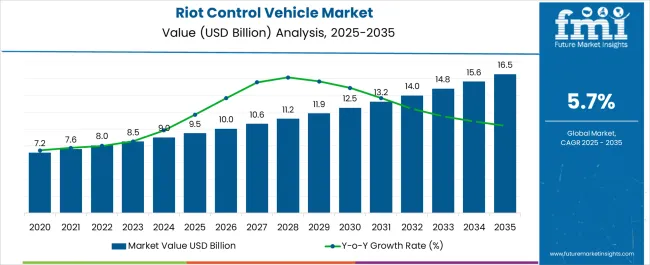
| Metric | Value |
|---|---|
| Riot Control Vehicle Market Estimated Value in (2025 E) | USD 9.5 billion |
| Riot Control Vehicle Market Forecast Value in (2035 F) | USD 16.5 billion |
| Forecast CAGR (2025 to 2035) | 5.7% |
The Riot Control Vehicle market is witnessing steady growth, driven by increasing urbanization, social unrest, and the rising need for law enforcement agencies to maintain public safety efficiently. The adoption of riot control vehicles is being supported by the demand for advanced crowd management solutions and non-lethal intervention methods. Modern vehicles are equipped with technologies that enable rapid deployment of chemical agents, water cannons, and other control mechanisms while ensuring the safety of personnel.
Continuous innovation in vehicle design, mobility, and integrated control systems is enhancing operational effectiveness. Government investments in public security infrastructure, along with the need for scalable and multi-functional solutions, are further driving market expansion.
Increasing emphasis on non-lethal crowd control, combined with regulatory compliance and ethical considerations, is shaping adoption trends As law enforcement agencies seek versatile, reliable, and high-performance vehicles to manage civil disturbances and public gatherings, the Riot Control Vehicle market is expected to maintain sustained growth, supported by technological advancements and evolving security requirements.
The riot control vehicle market is segmented by type of chemical used, type of flow systems, and geographic regions. By type of chemical used, riot control vehicle market is divided into Tear Gas, Foam, Colored Dyes, and Others. In terms of type of flow systems, riot control vehicle market is classified into Continuous Straight Stream, Automated Pulses, and Semi-Automated Single Pulse Systems. Regionally, the riot control vehicle industry is classified into North America, Latin America, Western Europe, Eastern Europe, Balkan & Baltic Countries, Russia & Belarus, Central Asia, East Asia, South Asia & Pacific, and the Middle East & Africa.
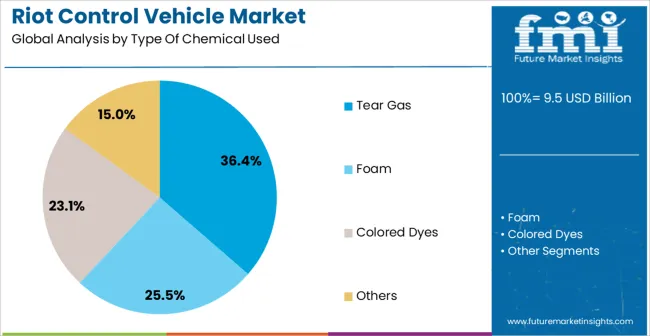
The tear gas segment is projected to hold 36.4% of the Riot Control Vehicle market revenue in 2025, establishing it as the leading chemical type. Growth in this segment is being driven by the widespread preference for non-lethal chemical agents that provide effective crowd dispersion while minimizing permanent harm. Tear gas enables law enforcement agencies to control large gatherings and civil unrest efficiently, with predictable dispersal patterns and rapid deployment capabilities.
The versatility of tear gas, combined with its established operational protocols and relative cost-effectiveness, has strengthened adoption. Vehicles designed to deploy tear gas are increasingly integrated with automated release systems, ensuring safety and precision during operations.
Continuous research and development in chemical formulations and delivery mechanisms have enhanced performance under varying environmental and tactical conditions As the demand for safe, reliable, and legally compliant crowd management solutions rises, tear gas is expected to maintain its leading position as the preferred chemical agent in riot control applications.
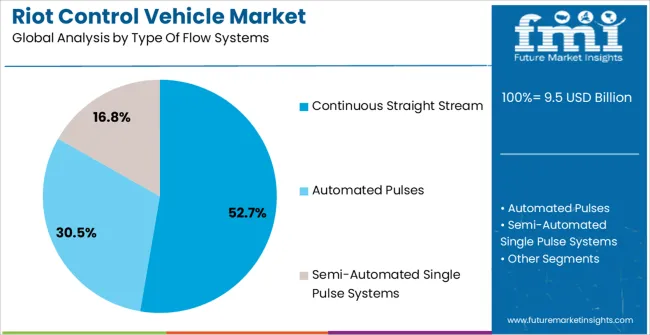
The continuous straight stream segment is anticipated to account for 52.7% of the market revenue in 2025, making it the leading flow system type. Its growth is driven by the need for accurate, high-pressure deployment of liquids such as water, foam, or chemical agents during crowd control operations. Continuous straight stream systems provide consistent output, enabling law enforcement personnel to maintain effective distance while controlling unruly gatherings.
The ability to target specific areas precisely reduces collateral impact and enhances operational efficiency. Integration with vehicle-mounted controls and automated monitoring systems further improves responsiveness and adaptability during dynamic situations.
Adoption is also influenced by the need for scalable and versatile systems that can operate under different environmental and tactical conditions As public safety agencies prioritize efficiency, reliability, and precise intervention capabilities, continuous straight stream flow systems are expected to retain their dominance in riot control vehicle deployments, reinforced by ongoing technological enhancements and operational effectiveness.
Increasing essentiality of riot control vehicles to control incidences of violent protests and civil unrest without the use of lethal force is anticipated to boost the demand for the riot control vehicles market in the near future. In addition, the introduction of new and innovative self-protection features, enhanced non-lethal weapons, high torque engines, and advanced armor are also expected to increase demand through the forecast period.
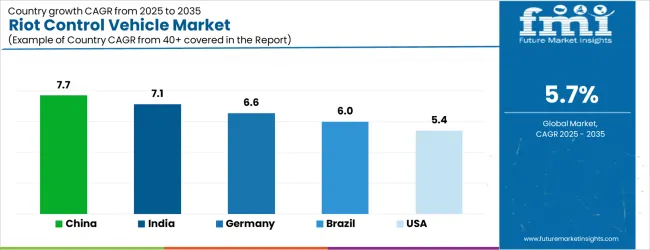
| Country | CAGR |
|---|---|
| China | 7.7% |
| India | 7.1% |
| Germany | 6.6% |
| Brazil | 6.0% |
| USA | 5.4% |
| UK | 4.8% |
| Japan | 4.3% |
The Riot Control Vehicle Market is expected to register a CAGR of 5.7% during the forecast period, exhibiting varied country level momentum. China leads with the highest CAGR of 7.7%, followed by India at 7.1%. Developed markets such as Germany, France, and the UK continue to expand steadily, while the USA is likely to grow at consistent rates. Japan posts the lowest CAGR at 4.3%, yet still underscores a broadly positive trajectory for the global Riot Control Vehicle Market. In 2024, Germany held a dominant revenue in the Western Europe market and is expected to grow with a CAGR of 6.6%. The USA Riot Control Vehicle Market is estimated to be valued at USD 3.5 billion in 2025 and is anticipated to reach a valuation of USD 3.5 billion by 2035. Sales are projected to rise at a CAGR of 0.0% over the forecast period between 2025 and 2035. While Japan and South Korea markets are estimated to be valued at USD 513.8 million and USD 276.4 million respectively in 2025.
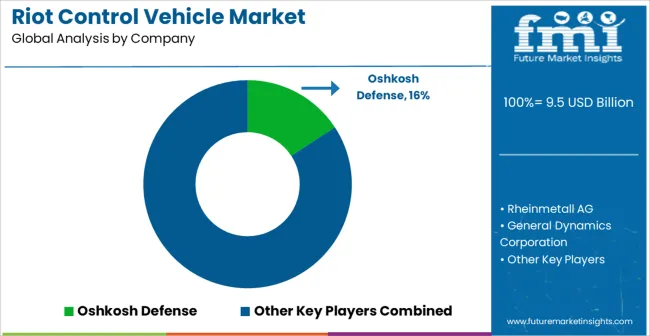
| Item | Value |
|---|---|
| Quantitative Units | USD 9.5 Billion |
| Type Of Chemical Used | Tear Gas, Foam, Colored Dyes, and Others |
| Type Of Flow Systems | Continuous Straight Stream, Automated Pulses, and Semi-Automated Single Pulse Systems |
| Regions Covered | North America, Europe, Asia-Pacific, Latin America, Middle East & Africa |
| Country Covered | United States, Canada, Germany, France, United Kingdom, China, Japan, India, Brazil, South Africa |
| Key Companies Profiled | Oshkosh Defense, Rheinmetall AG, General Dynamics Corporation, BAE Systems, Lockheed Martin Corporation, STREIT Group, INKAS Armored Vehicle Manufacturing, Lenco Industries, Inc., The Armored Group, LLC, Plasan, Paramount Group, Jankel Armouring Ltd., and IAG (International Armored Group) |
The global riot control vehicle market is estimated to be valued at USD 9.5 billion in 2025.
The market size for the riot control vehicle market is projected to reach USD 16.5 billion by 2035.
The riot control vehicle market is expected to grow at a 5.7% CAGR between 2025 and 2035.
The key product types in riot control vehicle market are tear gas, foam, colored dyes and others.
In terms of type of flow systems, continuous straight stream segment to command 52.7% share in the riot control vehicle market in 2025.






Our Research Products

The "Full Research Suite" delivers actionable market intel, deep dives on markets or technologies, so clients act faster, cut risk, and unlock growth.

The Leaderboard benchmarks and ranks top vendors, classifying them as Established Leaders, Leading Challengers, or Disruptors & Challengers.

Locates where complements amplify value and substitutes erode it, forecasting net impact by horizon

We deliver granular, decision-grade intel: market sizing, 5-year forecasts, pricing, adoption, usage, revenue, and operational KPIs—plus competitor tracking, regulation, and value chains—across 60 countries broadly.

Spot the shifts before they hit your P&L. We track inflection points, adoption curves, pricing moves, and ecosystem plays to show where demand is heading, why it is changing, and what to do next across high-growth markets and disruptive tech

Real-time reads of user behavior. We track shifting priorities, perceptions of today’s and next-gen services, and provider experience, then pace how fast tech moves from trial to adoption, blending buyer, consumer, and channel inputs with social signals (#WhySwitch, #UX).

Partner with our analyst team to build a custom report designed around your business priorities. From analysing market trends to assessing competitors or crafting bespoke datasets, we tailor insights to your needs.
Supplier Intelligence
Discovery & Profiling
Capacity & Footprint
Performance & Risk
Compliance & Governance
Commercial Readiness
Who Supplies Whom
Scorecards & Shortlists
Playbooks & Docs
Category Intelligence
Definition & Scope
Demand & Use Cases
Cost Drivers
Market Structure
Supply Chain Map
Trade & Policy
Operating Norms
Deliverables
Buyer Intelligence
Account Basics
Spend & Scope
Procurement Model
Vendor Requirements
Terms & Policies
Entry Strategy
Pain Points & Triggers
Outputs
Pricing Analysis
Benchmarks
Trends
Should-Cost
Indexation
Landed Cost
Commercial Terms
Deliverables
Brand Analysis
Positioning & Value Prop
Share & Presence
Customer Evidence
Go-to-Market
Digital & Reputation
Compliance & Trust
KPIs & Gaps
Outputs
Full Research Suite comprises of:
Market outlook & trends analysis
Interviews & case studies
Strategic recommendations
Vendor profiles & capabilities analysis
5-year forecasts
8 regions and 60+ country-level data splits
Market segment data splits
12 months of continuous data updates
DELIVERED AS:
PDF EXCEL ONLINE
Riot Control Equipment Market Size and Share Forecast Outlook 2025 to 2035
Vehicle Control Unit (VCU) Market Growth & Demand 2025 to 2035
Electric Vehicle Communication Controller Market Size and Share Forecast Outlook 2025 to 2035
North America Keyless Vehicle Access Control Market - Growth & Forecast through 2035
Control Network Modules Market Size and Share Forecast Outlook 2025 to 2035
Vehicle-Mounted Payment Terminal Market Size and Share Forecast Outlook 2025 to 2035
Controllable Shunt Reactor for UHV Market Size and Share Forecast Outlook 2025 to 2035
Vehicle Scanner Market Size and Share Forecast Outlook 2025 to 2035
Vehicle-to-grid Market Size and Share Forecast Outlook 2025 to 2035
Vehicle Transfer Case Market Size and Share Forecast Outlook 2025 to 2035
Vehicle Barrier System Market Size and Share Forecast Outlook 2025 to 2035
Control Room Solution Market Size and Share Forecast Outlook 2025 to 2035
Vehicle Acoustic DSP Chips Market Size and Share Forecast Outlook 2025 to 2035
Vehicle Cargo Box Market Size and Share Forecast Outlook 2025 to 2035
Vehicle Jump Starter Market Size and Share Forecast Outlook 2025 to 2035
Vehicle Moving Services Market Size and Share Forecast Outlook 2025 to 2035
Control Knobs for Panel Potentiometer Market Size and Share Forecast Outlook 2025 to 2035
Controlled-Release Drug Delivery Technology Market Size and Share Forecast Outlook 2025 to 2035
Vehicle Security Sensor Market Size and Share Forecast Outlook 2025 to 2035
Controlled Environment Agriculture (CEA) Market Size and Share Forecast Outlook 2025 to 2035

Thank you!
You will receive an email from our Business Development Manager. Please be sure to check your SPAM/JUNK folder too.
Chat With
MaRIA